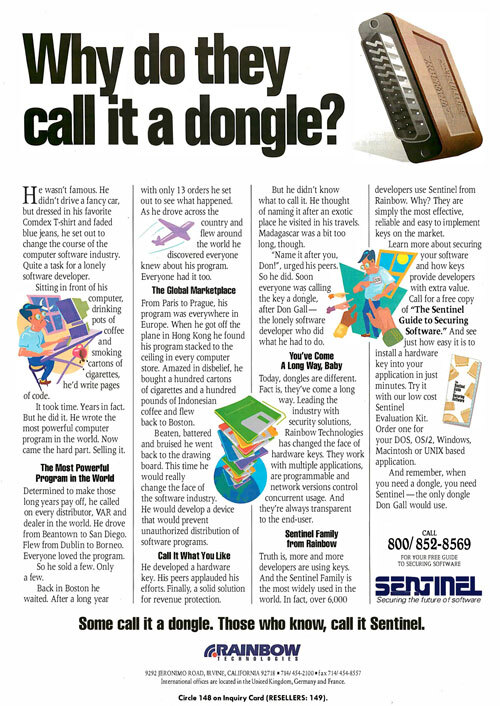
An example of a parallel-port dongle. (Wikimedia Commons)
The dongle’s original legacy as an antipiracy tool
Last year, when the latest iteration of the Mac Pro came out, one thing that may have confused observers looking at this machine, which they will likely never use, is the unusual placement of a USB-A port on the machine’s motherboard.
To those that only lightly follow technology, the existence of this port likely made no sense. But it reflects a decades-long legacy of tying security to actual hardware that, for some programs at least, persists to this day.
A 1984 New Scientist piece explained the dynamic that led to the growing popularity of dongles throughout the period, but noted that despite their goal of security, they ultimately were seen as easy to break by technical users:
The dongle is a small plastic box which plugs into one of the ports at the back of a computer. A program protected by a dongle contains a routine that asks a computer to check whether the dongle is present and sometimes to read a code from it. If it has not been plugged in the program will not run. Most dongles do not prevent programs from being copied, but they stop the copies from being used, since each copy needs a matching dongle to work.
Unfortunately, there is nothing to prevent the owner of a dongle-protected program from displaying the program code on his computer screen and removing the dongle check from it. One expert says this task takes about two hours.
The dongle system has been refined by some companies. Instead of supplying a program in plain computer code, some or all of the instructions are scrambled. The key to this simple encryption is held by the dongle which passes it to the computer’s operating system (the program which coordinates the computer’s operations). Once unscrambled, the program is loaded into the computer’s memory and runs in the normal way; but it is not difficult to remove the built-in checks.
For games, these approaches were eventually replaced by copy-protection schemes inside manuals or by different distribution approaches, like shareware. But dongles for more high-end or specialized software products, along with employee security, never really went away. In fact, they got more sophisticated, adding their own processing capabilities that interacted with the software being used.

(Internet Archive)
Of course, people aren’t aware where they actually came from in the first place, as The Atlantic’s Garber implied. This has led to fun stories, the most colorful of which was invented by the tech company Rainbow Technologies, which, in a 1992 advertisement than ran in Byte, invented a character named Don Gall who they claimed the device was named after.
“He wasn’t famous. He didn’t drive a fancy car, but dressed in his favorite Comdex T-shirt and faded blue jeans, he set out to change the course of the software story,” the fable started.
While obviously totally made up, it nonetheless became something of an urban legend.
These devices generally hooked up to serial or parallel ports throughout the 1990s, with adapters that allowed users to continue to plug in devices such printers. In terms of video games, cheat tools like the Game Genie could be thought of as dongles.
But in the late 1990s, these devices were able to shrink thanks to USB. These dongles, while less prominent than they once were, have largely stayed in common use in a handful of industries, specifically those that sell computer-aided design or manufacturing software, and those that that offer software for digital audio workstations. ACID and Autodesk, two manufacturers that specialize in are probably two of the best-known companies that rely on hardware security dongles in the modern day. These are the kinds of devices for which the Mac Pro has an internal USB-A port.
More common, however, are devices intended specifically for two-factor authentication, such as the YubiKey, which serve a similar security function, but for the user or the organization for which they serve, rather than to prevent piracy. These tools work in similar ways to the dongles of yore, perhaps with additional security mechanisms.
Speaking of USB, the switch of formats, which was ultimately a good thing for technology, helped create a pretty big market for dongles big and small, many of which connect to all variety of objects, from printers to TV sets. (Apple, the company that moved to USB early, is responsible for many of our dongles.)
The USB thumb drive is a great example of a dongle, and perhaps the most prominent example of flash disks around.
Similarly, video standards have a way of adding dongles to our lives. Ever converted HDMI to DVI to VGA to composite to RF? (No, just me?) Then you’ve lived the dongle life.
It’s a fact of life, and one that has only become more of a fact of life thanks to the rise of USB-C creating natural incompatibilities for dongles.